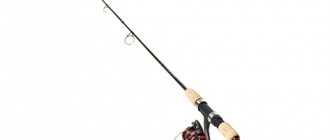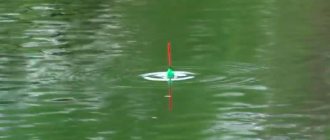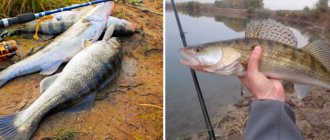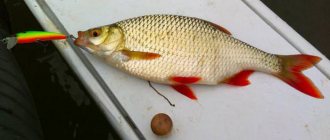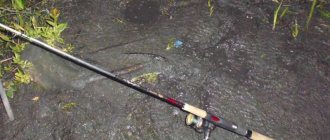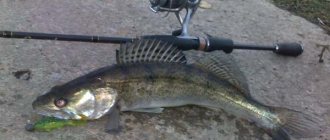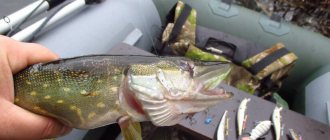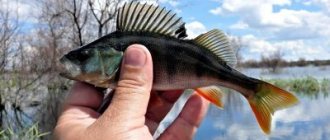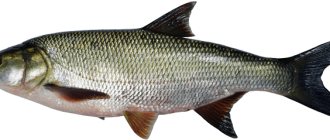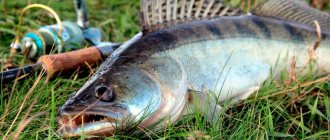What does ide look like?
This species is a relative of the carp, but in appearance it is more similar to a roach. They are related by their bright orange or crimson pelvic fins, but the color of the rather small scales with a golden-silver tint and the massive outline of the body suggest a discrepancy. The ide's head is relatively small, and its mouth is neat. Despite this, in the enthusiasm of the pre-spawning feast, they can even manage to capture pike bait. The color of the scales of this fish is uniform, without the usual dark stripe on the back.
Roaches dress up more simply than adults and do not have bright fins, so insufficiently experienced fishermen often mistake them for chubs or roaches.
Ide can take root both in a brackish bay with mixed water, and in a flowing river or quiet pond, so depending on the habitat, some differences are noticeable between representatives of the same species.
Ide diet
This species is an omnivore. The glutton is ready to grab almost any food with his small slanting mouth, which helps him quickly and effectively gain weight. When a pond/river is abundant with higher vegetation, ides have a passion for “salad,” adding worms, insect larvae, and crustaceans for taste. At the beginning of summer it is even caught by luring it with a bunch of grass.
Having gained 400-500 g on such a diet, the individual also exhibits predatory instincts, picking up small fish and insects caught in the water. Fishermen sometimes even use the method of catching ide with live bait, throwing it into places with strong currents. True, in this way you can catch nearby dace, perch, podust or asp, but you won’t have to suffer due to the lack of prey.
The most respectable fish prefer to feed in shallow water, where they can eat shellfish, fry and even small frogs.
The favorite treat of both young and old is known to all fishermen who have a passion for catching ide - peas. This is practically the only bait that this fish treats favorably, regardless of the time of year and place of residence.
Spinning fishing
To catch ide with a spinning rod, you should prepare the following gear:
- The fishing rod is light with dough from two to fifteen grams and two and a half meters long. It must have a fast action and be very rigid and durable.
- The fishing line should be 0.2 mm in diameter. It is advisable to use braided wire.
- The reel should have size 2500 bobbins.
- The hook is suitable number 5. It must be of excellent quality and have a sharp sting.
The following components should be used as bait:
- Sandwich made from maggot and pearl barley.
- Leeches.
- Worms.
- Peas.
- Artificial baits (wobblers).
The process of catching ide with a spinning rod has the following features:
- It should be cast into places with an uneven bottom and changes in depth.
- Posting artificial baits should be done at half-water, no more than one and a half meters from the surface.
- After casting the bait, you should make a short stop so that the wobbler can drop to the required water level. After this, you need to do a slow retrieve, which attracts the ide’s attention better than a fast one.
- The ide bites slowly and you should have very sensitive tackle. To recognize his kicks.
- You need to hook deftly, otherwise if the fisherman doesn’t succeed in hooking quickly, he will need to reel in the catch, which is not always easy.
Catching ide in spring
Yazis are extremely active from the beginning of the ice drift. As soon as the winter ice melts from the reservoir and the air is saturated with oxygen, this fish begins its pre-spawning glutton. Having settled down with a float rod near the mouth of the tributaries of the main river/lake and using ordinary worms as bait for catching ide, a successful angler can pull out the prey almost one by one.
During the spawning period, which begins quite early (at the same time as perch and pike), the fish are traditionally busy with their own business and do not want to bite. Males add a scattering of small yellowish warts to their everyday outfit and gather together with females in small rivers and streams near underwater plants. The spawning process lasts for 1-2 weeks: first, the oldest individuals give birth to offspring, and at the end, 3-5 year olds take part in the first marriage ceremony in their lives.
Spawning takes place at a temperature of about 13? C, and as soon as the water warms up to 15? C, adults begin to stubbornly restore their strength. So by the end of spring, fishermen who are able to put an insect on the water without the knowledge of the fish hiding in the grass are observing a pleasantly active bite.
At this time, catching ide from the shore is successful. In the spring (late May) you need to look for it at shallow depths in places with a rocky or sandy bottom and convenient snags behind which the fish can hide. Among their favorite spring dishes are insects, and beetles are rarely their taste, but grasshoppers attract a lot of attention. In addition, luck comes to fishermen who offer treats of worms and crayfish, and by the end of May - cherry-sized bread balls and bait in the form of an ant or caddis larva.
If a reservoir can provide fish with deep holes and snags, a pile bridge or at least a hydraulic structure, it can stay there for the summer. But in streams and small rivers, fishing for ide can only please you with roaches.
Ide like a perch...
At one time, during the summer months on the Oka, I became interested in fishing with a “spinner”. By that time, I had gained a fair amount of experience using rotating spoons in still water, and it concerned mainly one fish - perch.
It’s no wonder that on the river the same “minke whale”, which I “exterminated” in very large quantities, became the main object of interest. And, accordingly, a considerable volume of statistics on river perch soon accumulated. Other predators, of course, also came across, but, characteristically, chub, pike, and pike perch - all of them in their reaction to the “spinner” were very noticeably different from perch. For them, the optimal size of the spoon was somewhat different, the fishing locations were different, and the fishing features were different...
But with the ide, everything was different: he stayed side by side with the perch, and “ate” the most perch spoon. More precisely, perches and roaches found themselves in the same places, but their flocks still did not mix. On the long shallows with a slow current there were small holes here and there; in many of them it was possible to find a schooling predator. More often than not it was perch, but in some pits its place was firmly occupied by ide.
On different days, the perch and ide seemed to exchange positions. On the famous shallows, below the Serpukhov railway bridge, I knew up to a dozen points. Bypassing them sequentially, at first I “stuck” on each for up to twenty minutes or more, trying to “kill” everyone. Later, if I happened to catch one or two perches on the first few casts, I simply left the point for another, because I already knew from experience that within such a limited space the entire school consists of fish of the same “nationality” and the ide is somehow more interesting than the perch. In addition, there were no fundamental differences in the wiring technique and choice of spinner model. I caught more often with the “Comet” of the second number or with the “Long” - “one and a half” * trying to slowly move the spoon at the bottom across the current.
Another characteristic place on the Oka where ide behaved like perch was a large bay, a kilometer above the mouth of the Nara. I moved along the shore, throwing the “spinner” in front of me at an acute angle. Sometimes there were singles, but more often after the first bite there were three or four more from the same point, i.e. the predator clearly had a tendency to stay in packs. And again - a similar picture: the flock is either purely perch, or purely ulcer.
Both perches and roaches in that bay did not differ in size. The average weight of the “striped ones” was one hundred and fifty grams, while roaches were found to be a little larger. But in terms of the number of bites, everything was at a very good level for the July Oka, which made it possible to experiment.
And here’s what else turned out: both perches and roaches, everyone, as if by agreement, clearly preferred the same models of “spinners” from those that I offered them. The leader of the “rating” turned out to be “abush” Reflex, and, I suspect, “left”. In second place, both of them also had one model - the “acid” color Super Vibrax (Blue Fox).
Here you can, of course, start thinking that, supposedly, the perches and roaches were aimed at the same food object, and it was these spoons that most successfully imitated it. But the fact itself is important for us: two fundamentally different predators behave absolutely the same.
The last example illustrating the “perch” behavior of ide is associated with spinning fishing under dams on the Moscow River. You may remember my magazine article about fishing in such places with a wobbler alloy. The main object of hunting there was asp, but there was also a “by-catch”, and quite unexpected.
If the wobbler was floated along the main stream, that is, somewhere at a distance of fifteen meters or more from the coastline, it was “eaten” almost exclusively by asp. But as soon as the wobbler was launched close to the shore, roaches and perches began to “bite” the bait alternately. Unlike previous examples, here there was no “apartheid” between the perches and roaches - they stayed mixed up - and equally willingly attacked the wobbler, preferring, again, the same models, in this case they were small, medium-deep-water Salmo Hornet and Jaxon. Again, we can say that the perch and roach “grazed” the same food fish. Food competitors, in a word.
Fishing for ide in summer
In the last days of May, ides move to deep, cool places, most of which they will occupy almost until the end of autumn. As a rule, these are dumps, pre-channel tables, pits with reverse flow, and small whirlpools.
At this time, it switches to night mode and is encountered by fishermen only in the early morning or late evening, while the sun is not even visible on the horizon. Roaches, however, are less cautious and in a quiet place can swim to the surface in a flock even during the day. In cloudy weather and during the period of insect flight, an older individual may appear at shallow depths.
It is in hot weather that representatives of the species demonstrate their caution and capriciousness, so catching ide in the summer is more often successful for fishermen relying on bream, ruffe or roach. If you are specifically interested in ide, you will have to make additional efforts - use a camouflage suit, hide in the bushes, or lie down on the ground. In addition, it is necessary to calculate the appropriate bait and choose the right way to play.
In the summer, natural baits are used as bait for catching ide: bread bugs, night moths, gadflies, blue dragonflies, as well as other insects living near the given reservoir. Among artificial ones, the most effective are imitations of mayflies and caddis flies (in the second half of summer).
In large, deep rivers, ides can travel and do not stay in the place chosen by the fisherman. To attract trophy fish, bait is required. They are lured with steamed cereals with the addition of hemp cake or kvass grounds. Fish also like bait made from steamed rye crackers.
When choosing before fishing what to catch ide with, it is worth considering: if there is a silver carp in the river that also likes peas, it can interfere in the evening and at night. Only early birds can catch ides on pea porridge.
Fishing methods
A float rod is the most affordable way to catch ide on the surface or at the bottom. Thanks to feeding with clay bait in a certain place, you can achieve targeted fishing with bait that is barely washed away even in a strong current, and this is the most important key to ide. In very strong currents, use appropriate floats for the current.
Feeder gear is an equally accessible and productive method of fishing. The peculiarity of the method is the constant feeding of the point with a feeder load, which is sent to the same place using a certain technology.
Spinning also allows you to claim a catch in the form of ide, since it is a relatively predatory fish. The most popular are small spoons, small ulcer wobblers, silicone baits and foam fish. The main thing is soft wiring, and the weight of the sinker should not exceed 3 g, less is better.
Catching ide in autumn
With the onset of cold weather, the fish stops being lazy during the day and goes out hunting, choosing places close to the main currents, most often under hanging branches of willows and coastal bushes. Her biggest appetite flares up at 10-11 am, as well as 14-17 pm. At such moments, it is possible to catch ide in the fall using dragonflies, flies, crickets, grasshoppers, caterpillars and adult butterflies, as well as their skillful imitations.
By the end of September, he ceases to be interested in surface animals and opens the hunting season for young carp fish at the bottom. Therefore, fishermen begin in November to catch ide on a spinning rod with a spinner No. 00-1. Moreover, not only roaches, but also large adults fall for this small bait.
Catching ide in winter
According to L.P. Sabanev, ide is one of the most resilient fish, capable of surviving even sharp temperature fluctuations without harm. Therefore, in winter, when there is enough oxygen in the water, these fish continue to live an active life. Only in the most severe frost, or when the access of oxygen to the water is extremely limited, do flocks briefly fall asleep.
Fans of fishing prefer to organize winter fishing for ide on the last ice. At this time, his attention is attracted by small dark jigs and bloodworms, and plant-based mixtures should be used as bait. Among the live baits, maggots, bark beetles, worms, and burdock moth larvae also rule. Sandwiches made from these delicacies in combination with dough or porridge are especially tasty.
The most catchy places for catching ide in winter are located near snags. If there are none in the reservoir, fishermen often flood them with a load themselves so that fish can settle in the proposed apartment. In cold weather, the ide is characterized by sharp strikes, but it takes a long time to look at the bait, so slow retrieves are most effective.
Considering the snags, the need to use thin lines (main 0.3-0.4 mm) and the strength of the ide, you should be careful when fishing it.
Tackle for catching ide
Catching ide with a float rod
This method is effective in turbid water, for example during periods of ice drift or flood. You need to use a thin fishing line (0.14 -0.25 mm for roaches, 0.3 mm for adults) and a light, sensitive fishing rod with a hook number 4 or 5.
To catch ide with a fishing rod, it is best to get a rod 5-7 m long in order to be able to cast the bait over considerable distances without arousing suspicion among cautious fish.
Depending on the time of year, the bait is placed in the water column (0.8 - 1 m depth), or directly at the bottom. Floats should be spherical or ovoid, with a noticeable antenna, weighing 2-3 g. Then they will behave well in the current and record bites “for the flood.”
Catching ide with a spinning rod
Spinning fishermen usually use a set of gear used for fishing for perch or chub. As a rule, take a rod with a test weight of up to 25 kg, preferably even up to 10 kg and a length of 2.6 - 3 m.
The fishing line must be sensitive, so fishermen prefer not monofilament, but braided (0.12-0.16 m) with an inertial reel of 2500-3000. An extended spool is often appropriate. It is best to take a metal leash with protective fittings against attacks by pike.
Rotating baits perform best, while wobblers rarely seem to be worthy prey for ides, except perhaps the smallest ones of 4-6 cm. The selected spinners should work well when catching ides in a retrieve in a leisurely manner. If fishing is carried out in thickets and snags, the restraining resource of the gear becomes important.
Hooks for catching ide should be as sharp as possible, wear-resistant and strong. Chinese models successfully straighten even small specimens.
His bite is very light and careful, so if you hook too early, the fish caught on the tip of the lip will easily fall off the hook.
Fishing in the wire video
Selection and arrangement of seats
During the spring flood, almost all the fish leave the deep winter moorings, go to shallower, warmer places and stay there until autumn.
Ide, chub, and roach especially love the mouths of small rivers and streams, ravines and hollows through which streams of rainwater flow into the rivers. Saddles 2.5-3.5 m deep between two reaches also serve as a place for fish to stay; necks with a clay or gristly bottom and a stronger current; places directly adjacent to rifts; exits from deep places, especially where the riverbed approaches a steep, steep bank... Everything that can constitute food for fish swims here.
The best places for live fishing are channels below locks and mill dams, channels between reed thickets up to 2 meters deep, and in mountain rivers - places with a calmer flow between the riffles. Especially a lot of varied and large fish are found where the main stream approaches places abounding in mayfly larvae (“grandmothers”). Mayfly is found in clayey shores and is the most delicious food of all fish species. (See Fig. 41). Fishing is also good near the pile abutments of bridges, below the lull, where the right and left streams of water flowing around the abutments converge again and form a smooth, calm current.
Having identified a place for fishing, an amateur fisherman must thoroughly examine the bottom of the reservoir, its topography, depth, strength of current, select a flat area with an average depth and drive one or two stakes here for mooring the boat.
On mountain rivers with strong currents and a rocky bottom, a place for fishing and a boat mooring is arranged as follows: the most spread-out, double-topped fir or spruce, up to 3 meters high, is cut down; a heavy stone - an anchor - is tied to the partially chopped off top of the tree, and a “float” from a stump of dry wood is tied to the thickest branch of the butt part. Then the tree is transported in a boat to the chosen place for fishing and dumped into the water. The load drags the top of the tree down to the bottom, and the butt part rises and forms a barrier in the water. Only the “float” floats to the surface of the water. The fisherman ties the boat to one of the thick branches of the tree. Below it, a slow flow forms. In a mountain river, this alone is often enough to attract fish. And when you arrange additional feeding - “bait” for the fish, you can fully count on a good catch.
On lowland rivers, when constructing a berth for a boat, they usually use one stake. Its lower, pointed end is sometimes covered with sheet iron, and a small tube or ring is put on the upper end so that when the stake is driven in with a heavy wooden mallet, the upper end of the pole does not split. When the fisherman ties the boat to a stake behind the middle bench and sits on it himself, the boat takes a position across the current and is held quite steadily.
Now it is necessary to set up a “bait” for the fish, that is, lower the pre-prepared bait under the water near the driven stake.
Complementary foods are prepared from bran, steamed hemp or sunflower cake, from steamed bread grains (oats, wheat, rye, corn) or from flour. It is lowered under water in a mesh bag or using some other device two to three meters from the pin. The following animal baits are successfully used: ant eggs, bloodworms or chopped red worms mixed with soil.
For live fishing, two places are usually chosen where the bait begins to fall in the spring. The bait should not fall asleep in the evening, as some inexperienced fishermen do, but, if possible, during the hours when the angler plans to go fishing. If an angler fishes early in the morning, he should also add bait
early in the morning or about two hours, an hour before fishing. In this way, the fish are taught to visit the designated place at the scheduled hours for fishing.
Article on the topic: Flavoring baits for carp fishing
In no case is it recommended to add leftover complementary food or the complementary food itself before finishing fishing.
Figure 36 shows two types of bait: k - cabbage made from dough mixed with bran or steamed cake, into which an iron ring is smeared; m - bait in a mesh bag.
In places with a calm and even current, the bait can be lowered to the bottom without tying it to a stake. In these cases, bran, cake or steamed grains are pre-mixed with clay.
When the fisherman does not have grain food, it is useful to fill in three or four buckets of fresh road clay soil as
On the Kama River and in the lower reaches of the Vyatka, special bridges are widely used for fishing “with a wire” from the shore*
ki-goat. The structure of such walkways is shown in Fig. 37. When the water level changes, they move.
Sometimes, when fishing from the shore in a river with a strong current, hidden “drives” are made in the water within the distance of casting a hook with a nozzle. To do this, in a chosen place, at a right or slightly smaller angle to the shore, at a depth of 1 to 1.5 meters, four stakes are driven in. Then a lattice shield with a height of 1 to 1.5 meters and a width equal to the distance from the first to the last stake is woven from fascine or wicker. This shield is immersed above the stakes and pressed against them with the Baking. And so that the waves from passing steam codes do not move it from its place, the shield is tied to stakes. Such barriers - “drives” - attract a lot of fish such as dace, roach, silver bream, roach, podust and chub. If a “stop” is set up near the main riverbed or a deep reach, then over time larger fish will stick to it.
The process of fishing "in the wiring".
But now all the preparations for fishing have been made: the rod has been assembled and equipped, a place has been chosen, backfilling of bait has begun...
The fisherman prepares a bait for baiting a hook, takes with him a landing net, a cage or a basket for the caught fish, at the appointed time he carefully approaches the desired place and ties the boat to a stake. Using a depth gauge, he once again checks the “release” and finally sets the length of the line: the distance from the top of the rod to the float should not be more than one and a half length of the rod. The fisherman starts fishing.
He puts a “granny” larva or three or four “maggots” on the hook, lowers them into the water near the boat and takes the rod in his right hand. The weight carries the nozzle down, it quickly reaches the bottom, and the float takes a vertical position on the surface of the water and immediately sets off on its first swim, downstream. The rod should be kept raised so that the line is always in a tense position, but does not delay the free floating of the float.
The float reached the place where the bait is located at the bottom of the river. At this moment you need to watch him especially closely... But the first swim has not yielded anything yet. When the float moves away from the boat for the entire length of the measured line and rod, a smooth hook is made with your hand, and the float is pulled towards the boat. The rod goes all the way back. Then the float is picked up by the left hand and passed to the right, the rod again rises up and back to full capacity, and the left hand picks up the leader and leash with the hook and nozzle and again lowers them into the water near the side of the boat. The nozzle goes into the depths, the float, having taken a standing position, sets off again.
So he again approached the place where the complementary food is located and suddenly, lingering for one moment on the surface, disappears under the water. The fisherman makes a smooth swing of the rod back, and it... bends into an arc: a large fish entered on the fishing line in the depths of the river, offering strong resistance. It is necessary to take into account the possibility of the line breaking, so it is necessary to timely parry the unexpected throws of the Underwater “enemy”. Having reeled almost the entire supply of line from the reel, the fish finally stops, and Ryblov begins, meter by meter, overcoming stubborn resistance, to take the line back onto the reel. The fish was already very close. The fisherman slowly but steadily pulls it towards the boat itself. He can already see the “prey”: a handsome red-finned chub appears on the surface of the water. But at the moment when the angler takes the rod in his left hand in order to take the landing net with his right hand, the chub rushes headlong into the depths, trying to hide under the boat. An exciting, critical moment! Every effort must be made not to let the fish go under the boat and not to let him wrap the line around the stake.
Article on the topic: Fishing with single baits
The fishing tackle tested before fishing turned out to be in good condition. The chub, having exhausted all its strength, lies down on its side. The fisherman pulls him to the boat, places a landing net under him and, with some difficulty, lifts his catch into the boat...
A dry, dispassionate description of the fishing process says nothing about the experiences of the fisherman himself. The picture of this description will not be complete if nothing is said about these experiences. The fisherman’s feelings are especially acute at the last moment of his preparations, when the fisherman is already near the boat at the stake, and the fish approaching the bait with its powerful splashes lets him know that a large fish is approaching the bait. At this moment, the fisherman’s nerve tension reaches its limit.
To an outsider - not a fisherman, it sometimes seems that the fisherman is an impassive creature, that he is completely absorbed in the process of fishing and does not experience any special experiences and does not even notice the beautiful nature surrounding him. This is not true. The overwhelming majority of real fishermen engage in fishing, the main activity, because it is carried out in an environment and against the backdrop of wonderful, enchanting pictures of nature, far from noisy cities and in an environment conducive to the rapid restoration and strengthening of one’s physical strength.
The main thing on which the success of live fishing depends is the correct choice of place.
When choosing a location, it is necessary to thoroughly study not only the fishing area itself, but also the entire area of the river where the equipment for fishing is supposed to be carried out. In no case should you choose areas where seine or net fishing is carried out by commercial fishermen. It is also impossible to arrange sizh where the bottom of a flowing reservoir or river is uneven or where it gradually decreases; in these cases, it is impossible to set the correct “release” of the line, and the bait at the end of the swim rises too high from the bottom. If it is difficult to find a flat area for fishing, it is better to stop at the exits from deep reaches and holes, where the river bottom gradually begins to rise again.
You cannot fish in the same places all year round. Fish, depending on the season and even on the weather and time of day, changes feeding and stopping places. So, during summer floods, fish migrate for some time to the mouths of small rivers and even ravines, along which streams of rainwater rush into the river. In summer, during the hottest time of the day, fish tend to stay in the channels between the reeds, at the edge of the reeds, or under coastal trees hanging over the water.
Changes in the water level in a reservoir have a great influence on large fish. When the water rises after rains or for some other reason, the fish rush to river floods, to shallower places, and vice versa, when the water level drops, the fish go to deeper places. Only when a normal water regime is established in a flowing body of water does the fish return to its constant favorite places for a given season.
When fishing “in the wire”, the correct choice of nozzle is also important. It happens that two or three days ago you caught fish perfectly with grains of steamed wheat or oats, but today the fish does not touch this bait at all, and your neighbor, who fishes not far from you, gets bite after bite. It turns out that today the fish prefer a bait made from a small bunch of thread
Article on the topic: Tactics for catching large carp
What does the success of live fishing depend on?
Green algae for all other baits. Your neighbor figured out this “whim” of the fish before you. Rice. 39.
During the mass emergence of mayflies, it is pointless to catch even such a favorite fish bait as maggot or “granny”. In this case, you need to quickly rearrange your gear, pick up mayflies swimming past the boat and fish on top of this bait.
The following phenomena have also been noticed: for several days after the bait is filled in, the fish are caught perfectly, the fisherman takes home record catches. Then the catches become smaller and smaller every day, and finally, one “fine” day, the fisherman comes home with an empty basket. The fact is that you cannot endlessly fish in one place, especially every day. You need to give the fish and the place a “break.” 'It is recommended to arrange two sits with the fish attached to them and alternate fishing to give new schools of fish the opportunity to settle in the fished places.
The correct selection and preparation of bait for attracting fish also plays an important role. If you fish all summer with bait made from nothing but steamed grains, and your neighbor flavors the same bait with some odorous substance that attracts fish, or from time to time adds steamed hemp cake to the bait, naturally, your neighbor’s catches will be richer. The fish will prefer to feed where more tasty food is prepared for it.
An important factor influencing the success of live fishing is weather changes, especially in summer. So, when inclement, cold weather approaches, all fish, with the exception of burbot, stop being caught on fishing rods. In persistent hot weather in the middle and end of summer, the fish becomes inactive and lethargic, moves to deeper places, under steep banks and to holes with spring water outlets and settles there. You can take it at this time only with a medium and small-sized spoon baited with bloodworms and a jig.
In autumn, when the water in reservoirs is already sufficiently cooled and the fish sense the imminent approach of winter, weather changes affect it less. At this time, trying to stock up on fat for the winter, it often does not stop biting even in cold weather, but you need to look for it in deeper places.
Fishing stops completely when a cold northeast or north wind blows.
Fishing results are greatly affected by faulty fishing gear. Before (every serious fishing) it must be carefully checked at home. Hooks must always be perfectly sharp, tenacious and correctly selected in size in accordance with the prepared bait. You must not hook the cockchafer or
mend on a small hook or put a bloodworm or maggot on a heavy large hook.
It is also not recommended to hide the hook tip in it when baiting the bait. When biting, the fish does not feel the bait, but sucks it in along with the water, not paying attention to the sting of the hook. In those cases when the hook tip is hidden inside the bait, especially when using hard, dense baits, there are many so-called empty bites: when hooking, the hook does not catch the fish, but is pulled out of its mouth along with the hard bait.
Loud conversation, unusual noise or knocking on the bottom or side of the boat will certainly also affect fishing. Even the shadow of the angler and his rod scares away the fish, and this circumstance must be taken into account when choosing a place for daytime fishing.
